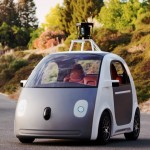 The recent incident that saw the Google driverless car have a slow-motion crash with an oncoming bus highlighted the challenges involved in transitioning to a driverless world.
The recent incident that saw the Google driverless car have a slow-motion crash with an oncoming bus highlighted the challenges involved in transitioning to a driverless world.
Whilst it’s relatively straightforward to communicate intent between two (or more) driverless vehicles, it’s much harder for a driverless car to know what a human intends to do.
The transition to a driverless world
Most new cars already have a significant amount of driver support built into them, whether it’s cruise control, parking support or even lane warning systems.
These are fantastic and have made our roads considerably safer, but they don’t offer much autonomy and don’t require much in the way of data sharing.
We will probably then move into a world where more data is shared to make cars more autonomous, with this data moving not only between cars but between the infrastructure too, before then moving to an environment of full autonomy powered by high levels of data sharing.
A successful transition will require strong collaboration across industry, government and academia. A paper published by the UK government last year aimed to provide a code of practice by which manufacturers could ensure their tests met the needs of all possible stakeholders.
The Nordic model
Swedish car giant Volvo believe that the best approach is by using it’s so called Nordic Model, which taps into the knowledge of public, private and academic sectors to ensure the transition is a smooth one.
“Autonomous driving has the potential to revolutionise car safety. This technology saves lives. AD also improves traffic flows, enhances air quality and saves people time. This technology should be introduced as quickly as possible. The best way to do this is to get everyone involved working together at the earliest opportunity,” they say.
The comments were made at a recent seminar held at the Swedish parliament and come at a time when Volvo’s ‘Drive Me’ project is in full swing.
The project sees Volvo working with 100 families in Sweden and gives them driverless technology to use on real worlds and in real ways.
Volvo believe that for the transition to be a smooth one, it’s vital that everyone works together rather than having a mishmash of regulations, technological duplication and a lot of unnecessary expense.
This is especially so when the challenge of driverless technology is increasingly a global one, and it simply will not work if individual countries adopt different standards and strategies.
“Our starting point is that both the public and private sectors stand to benefit from new technologies and industries, so it is better to build bridges and work together than to all go in different directions,” Volvo say.
A collaborative approach
It’s an approach that’s echoed by Thomas Glendinning, Automotive Industry Analyst at BMI Research.
“We would agree that a collaborative solution is the best solution to a lot of the problems around introducing self-driving cars. A simple arms race in the autonomous technology space between car makers, major suppliers and tech firms would not be productive. Instead, industry stakeholders (businesses, governments, universities) all need to first collaborate on setting industry standards for autonomous tech to simply set up the rules of the game before any major roll-out of autonomy to consumers can be considered. Otherwise, the ‘mishmash’ of competing technologies could actually stall the broader introduction of autonomy,” he says.
Of course, desiring such a cooperative environment is a long way from achieving one. Time will tell just how our transition to driverless pans outs.
Volvo propose that driverless cars won't be marked to stop people 'taking them on'.
Yes, I saw that. A sensible decision I think.
LSE think that driverless cars will be 'bullied'
http://www.lse.ac.uk/newsAndMedia/PDF/AVs-negocia…
Interesting find Fabian, thanks for sharing.
These "combative" drivers should have their license pulled. The self driving cars are likely to provide legally admissible camera recordings of their misbehaviour. The police should aggressively prosecute.
Driverless cars. The answer to a problem nobody had.
The number of fatalities on the road would suggest otherwise Betty.
What about the flip side of drivers "bullying" these machines? Sometimes in difficult traffic conditions one "asks a favour" of another driver by visual signals to complete a manoeuvre. No longer possible with these robotic cars.
I am very much looking forward to a future when driverless cars are ubiquitous.
A future of towns and cities without parked cars, a future where disabled people are able to travel more easily, a future in which thousands of lives are saved every year.
It will be a monumental change for the better.